Marrakech Food: A Guide to the Best Local Eats
Looking for the ultimate foodie’s guide to the Pink City? Here’s everything you need to know about Marrakech food!
If you’re planning a trip to Marrakech, one thing you won’t want to miss is the food. This vibrant city is known for its delicious cuisine, which blends North African, Mediterranean, and Middle Eastern flavors.
From hearty stews to sweet pastries, there’s something for everyone to enjoy, so we put together the ultimate guide to Marrakech food so you can prepare yourself (and your taste buds) for your trip!
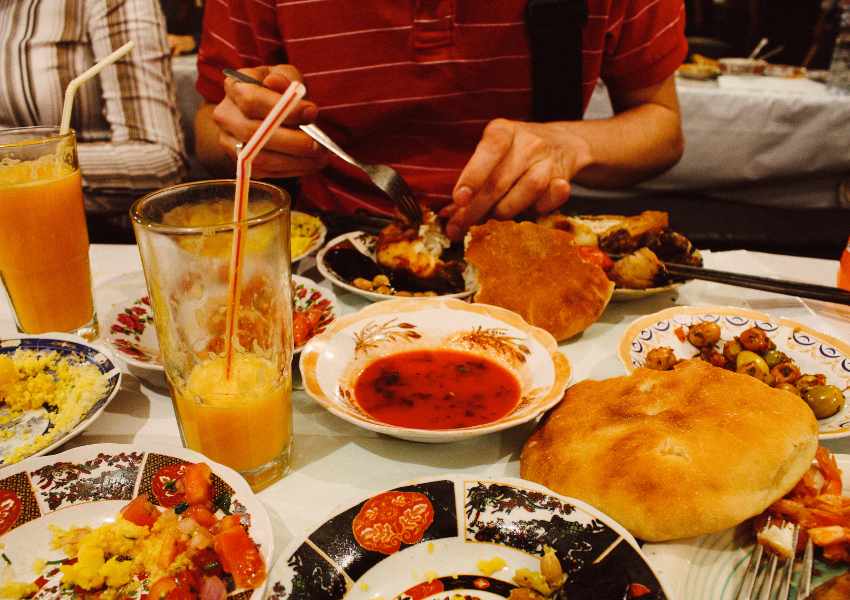
The Essence of Marrakech Food
When it comes to Marrakech food, there’s one word that sums it up perfectly: flavor. The city’s cuisine is a melting pot of cultures, with influences from Berber, Arabic, and French cooking. The result is a unique blend of spices, herbs, and ingredients that will tantalize your taste buds.
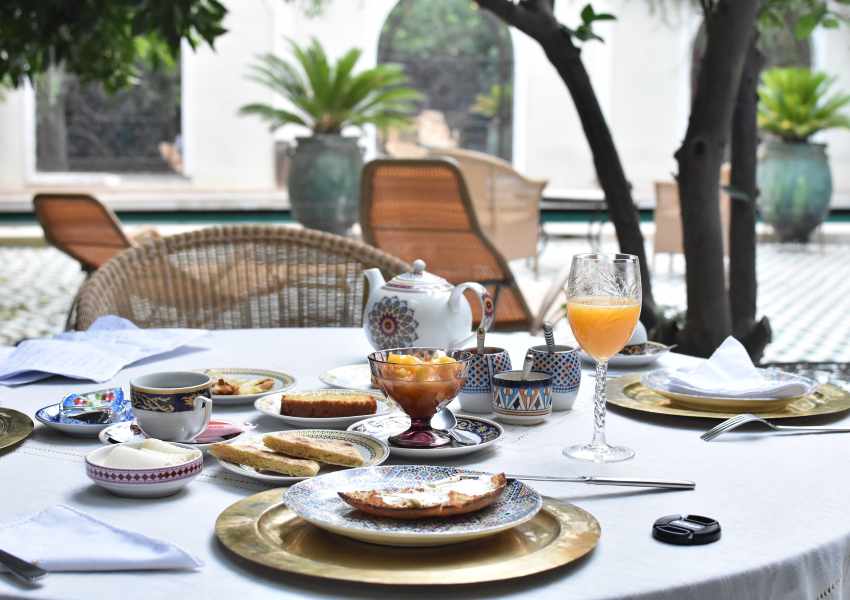
One of the standout features of Marrakech food is the use of spices. From cumin and cinnamon to saffron and turmeric, these aromatic seasonings are used in abundance to create complex and flavorful dishes. Some of the most popular spices used in Marrakech cuisine include:
- Ras el hanout: a blend of up to 30 different spices, often used in tagines and stews.
- Harissa: a fiery chili paste that’s used to add heat to dishes.
- Cumin: a warm, earthy spice that’s used in everything from soups to grilled meats.
- Ginger: a zesty spice that’s used to add flavor to sweet and savory dishes alike.
Another defining feature of Marrakech food is the use of fresh, local ingredients. From the juicy tomatoes and crisp cucumbers in a Moroccan salad to the tender lamb in a tagine, the food in Marrakech is all about showcasing the best of what the region has to offer.
Of course, no discussion of Marrakech food would be complete without mentioning the iconic mint tea. This sweet, fragrant tea is a staple in Moroccan culture and is often served alongside meals or as a refreshing afternoon pick-me-up.
In short, Marrakech food is all about bold flavors, aromatic spices, and fresh ingredients. Whether you’re trying street food from a market stall or dining in a fancy restaurant, you’re sure to be impressed by the culinary delights on offer.
Must-Try Food in Marrakech
If you’re visiting Marrakech, you’re in for a treat when it comes to food. The city’s cuisine is a mix of African, Arab, and Mediterranean influences, resulting in a unique blend of flavors and spices. Here are three must-try dishes you shouldn’t miss:
Tagine
Tagine is a traditional Moroccan dish that is named after the clay pot it is cooked in. The pot has a cone-shaped lid that helps to trap steam and cook the food slowly, resulting in tender and flavorful meat.
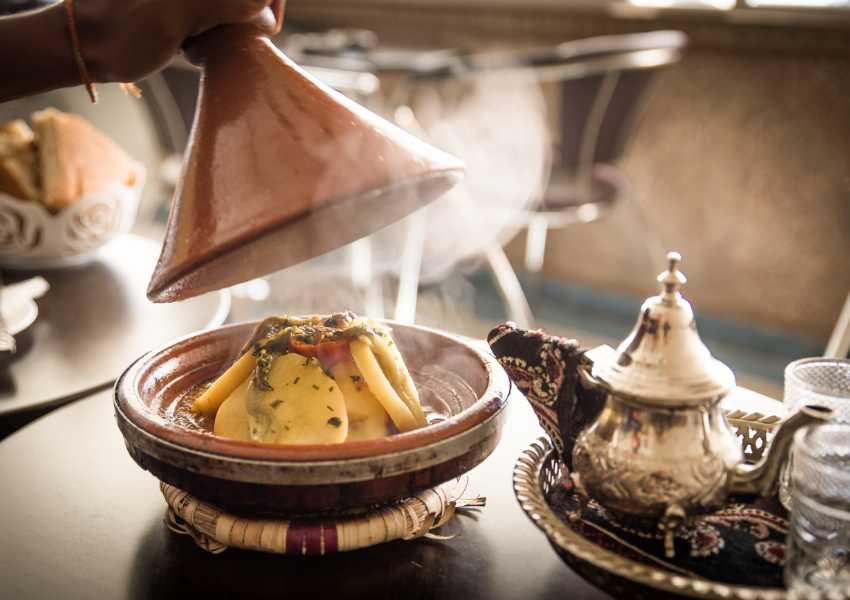
The dish can be made with chicken, lamb, beef, or fish, and is typically served with vegetables and couscous. Some popular tagine variations include:
- Chicken with preserved lemons and olives
- Lamb with prunes and almonds
- Beef with tomatoes and chickpeas
Couscous
Couscous is one of the most iconic Marrakech dishes and consists of steamed semolina grains that are mixed with vegetables and meat.
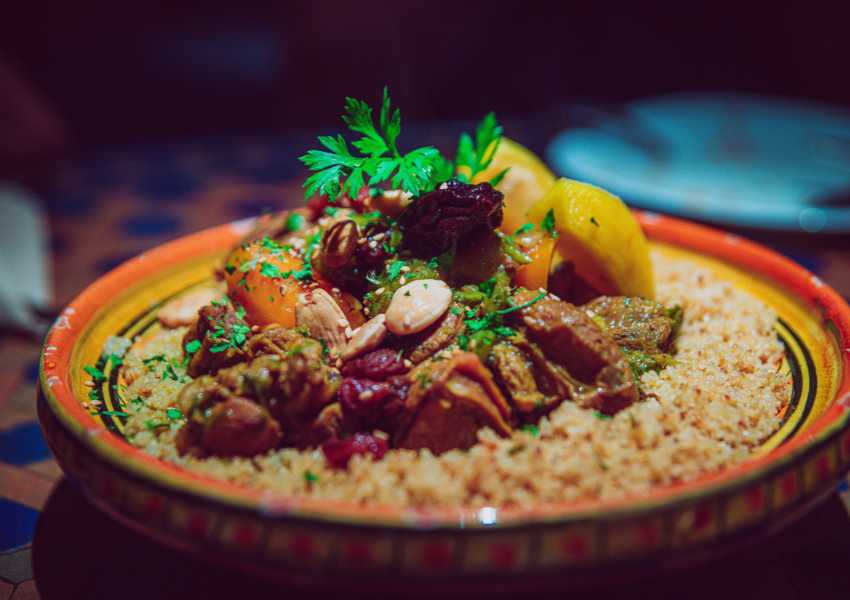
The meat can be chicken, lamb, beef, or fish, and the vegetables can include carrots, turnips, onions, and chickpeas. Couscous is often served with a spicy harissa sauce on the side.
Pastilla
Pastilla is a sweet and savory pastry that is traditionally made with pigeon meat, almonds, and cinnamon.
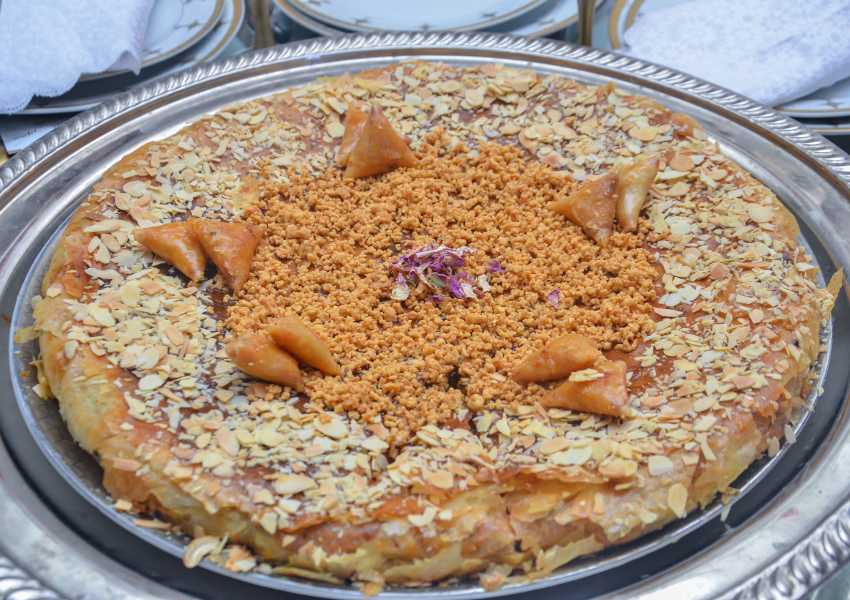
The meat is cooked with spices and then layered with phyllo dough and powdered sugar. The dish is then baked until the pastry is golden brown and crispy. Pastilla can also be made with chicken or fish, and is often served as an appetizer or a snack.
What is the Most Iconic Marrakech Food?
One of the most iconic dishes in Marrakech is tagine, a slow-cooked stew made with meat, vegetables, and spices.
The dish is named after the conical earthenware pot it’s cooked in, and it’s often served with couscous or bread. Another popular dish is harira, a spicy soup made with lentils, chickpeas, and tomatoes. It’s typically served during Ramadan to break the fast, but you can find it year-round in many restaurants.
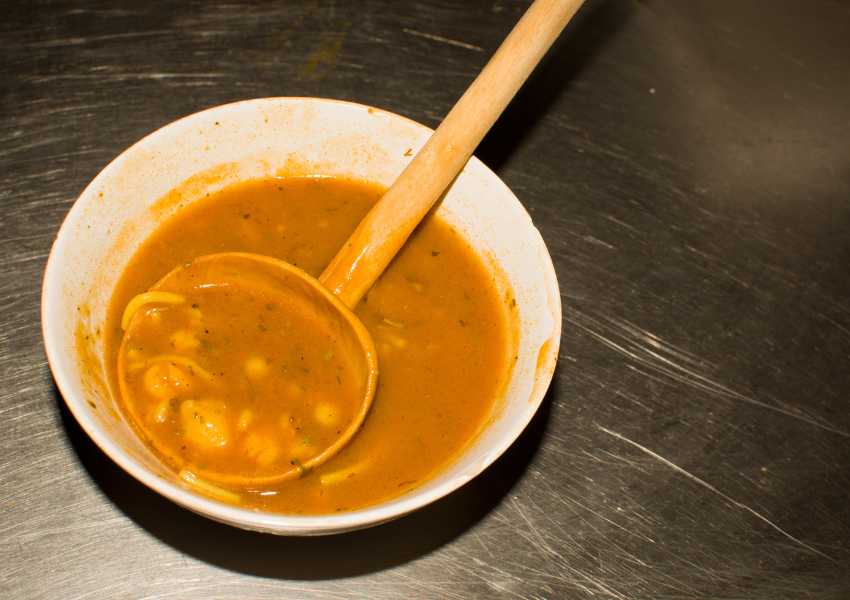
If you have a sweet tooth, you’ll love the desserts in Marrakech. One of the most famous is baklava, a pastry made with layers of phyllo dough, honey, and nuts. Another popular treat is chebakia, a fried dough that’s coated in honey and sesame seeds.
Street Food in Marrakech
Marrakech is a food lover’s paradise, and the street food scene is no exception. The city is known for its vibrant and colorful food markets, where you can find all sorts of delicious treats.
Here is some of the most popular street food in Marrakech you should try:
Snail Soup
If you’re feeling adventurous, you should definitely try snail soup. This is a popular street food in Marrakech, and you can find it in many of the Marrakech food markets.
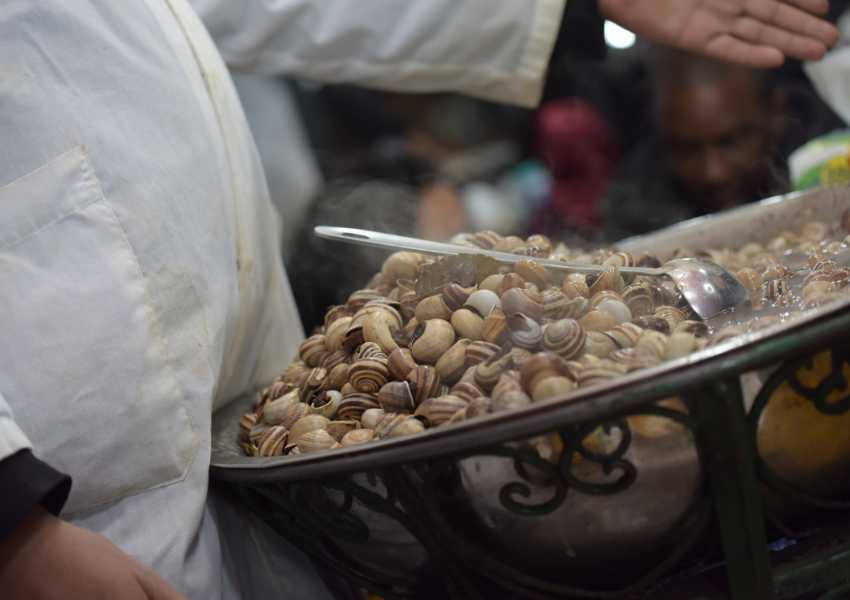
The soup is made with a variety of herbs and spices, and of course, snails. It’s a unique and flavorful dish that you won’t find anywhere else.
Maakouda
Maakouda is a type of potato fritter that is popular in Marrakech. It’s made with mashed potatoes, onions, and spices, and then fried until crispy. You can find maakouda in many of the food markets around the city, and it’s often served with harissa sauce or other dipping sauces.
Brochettes
Brochettes are skewered meat kebabs that are a popular street food in Marrakech.
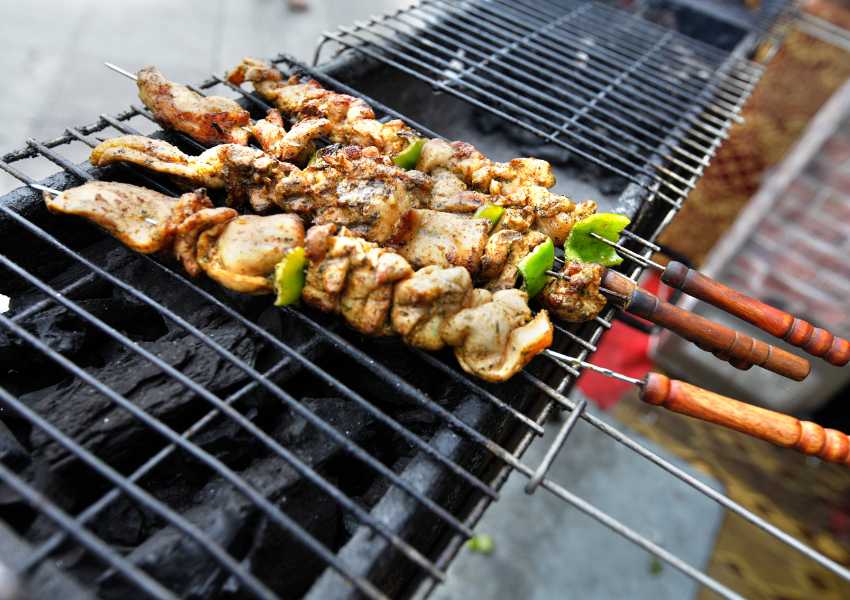
You can find them in many of the food markets around the city, and they’re often made with lamb, beef, or chicken. The meat is marinated in a variety of spices and then grilled over an open flame. They’re a tasty and filling snack that you can enjoy on the go.
Marrakech Food Markets
If you’re a foodie, you’ll love the food markets in Marrakech. Here are two of the most famous ones:
Jemaa el-Fnaa
Jemaa el-Fnaa is the most famous food market in Marrakech. It’s a huge square in the middle of the city, and it’s always bustling with activity.

When you visit Jemaa el-Fnaa, you’ll find food stalls selling everything from grilled meats to fresh juices. Some of the most popular dishes include:
- Tagine: A slow-cooked stew made with meat, vegetables, and spices.
- Couscous: A dish made with tiny grains of semolina and vegetables.
- Harira: A hearty soup made with chickpeas, lentils, and tomatoes.
The best time to visit Jemaa el-Fnaa is in the evening, when the square comes alive with music and entertainment and becomes a mecca to experience Marrakech food culture at its best.
Rahba Kedima Spice Market
Rahba Kedima is a small market in the heart of Marrakech’s medina. It’s known for its colorful spice stalls, which sell everything from saffron to cumin. When you visit Rahba Kedima, you’ll be hit with a wave of unfamiliar scents and flavors.

In addition to spices, you can also find other food items at Rahba Kedima, such as dried fruits, nuts, and herbs. It’s a great place to stock up on ingredients for your own Moroccan cooking.
Overall, Marrakech’s food markets are a must-visit for any food lover. Make sure to come hungry and ready to explore!
Marrakech Food: Must-Try Desserts
Morocco is known for its rich culinary traditions, and Marrakech is no exception. In addition to savory dishes, Marrakech is also home to a variety of delicious traditional desserts. Here are two popular options:
Chebakia
Chebakia is a sweet, fried pastry that is typically served during Ramadan. The dough is made with flour, sesame seeds, anise, cinnamon, and orange blossom water, and is shaped into a flower before being fried and dipped in honey. The result is a crunchy, sweet treat that is perfect for satisfying your sweet tooth.

Sellou
Sellou is a traditional Moroccan dessert that is often served during special occasions, such as weddings or religious holidays.
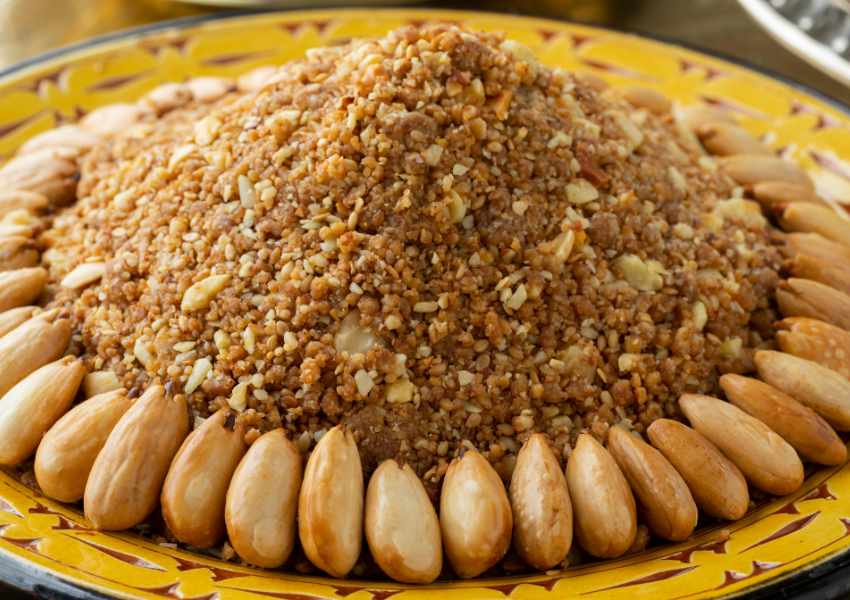
It is made from a mixture of almonds, sesame seeds, flour, sugar, and butter, and is typically served in small, bite-sized pieces. Sellou has a nutty, slightly sweet flavor and a crumbly texture that makes it a unique and delicious dessert option.
Drinks in Marrakech
When it comes to drinks in Marrakech, you’ll find a variety of options to quench your thirst. From traditional mint tea to fresh juices, there’s something for everyone.
Mint Tea
Mint tea is a staple in Moroccan culture and is often served as a welcoming gesture to guests. It’s a sweet and refreshing drink made with green tea, fresh mint leaves, and sugar. The tea is typically served in small glasses and poured from a teapot with a long spout.
If you’re looking for a place to enjoy mint tea in Marrakech, head to one of the many cafes in the medina. You can also experience a traditional tea ceremony at a riad or guesthouse.

Fresh Juice
Marrakech is known for its fresh and flavorful juices. You’ll find vendors throughout the city selling a variety of juices made with local fruits and vegetables. Some popular options include orange, pomegranate, and carrot juice.
One of the best places to try fresh juice is at the Jemaa el-Fnaa square. You’ll find several vendors selling freshly squeezed juice at affordable prices. Be sure to try the orange juice, which is a local favorite.
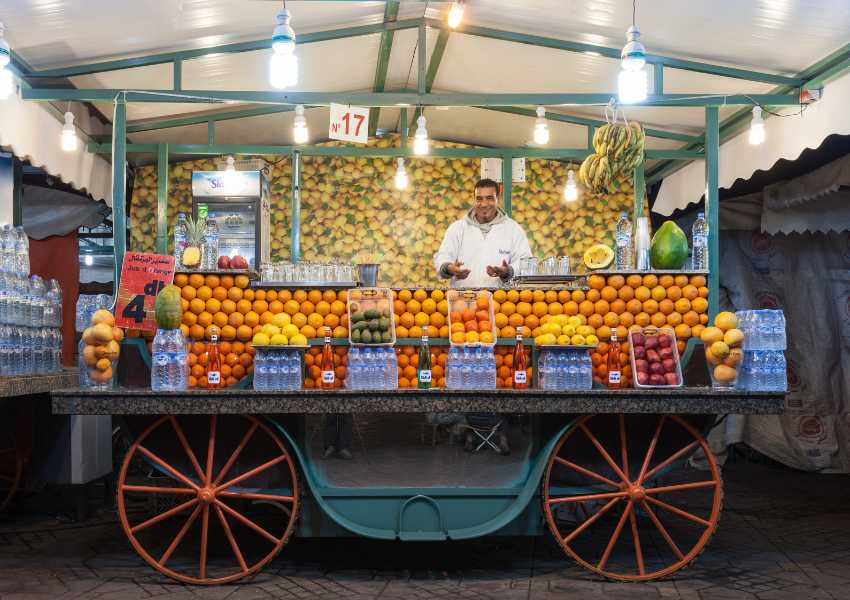
Vegetarian and Vegan Options in Marrakech
If you’re a vegetarian or vegan, you might be wondering what options are available to you. Luckily, the Marrakech food scene has plenty of options for vegas and vegetarians!
Vegetarian Options
Vegetarian options are widely available in Marrakech. Many traditional Moroccan dishes are vegetarian or can be made vegetarian by simply omitting the meat. Here are a few dishes you should try:
- Tagine: A tagine is a traditional Moroccan stew that is cooked and served in a clay pot. Vegetable tagines are a popular vegetarian option and can be made with a variety of vegetables like potatoes, carrots, and zucchini.
- Briouats: Briouats are a type of Moroccan pastry that are usually filled with meat, but vegetarian options are available. The filling can be made with cheese, spinach, or potatoes.
- Zaalouk: Zaalouk is a Moroccan salad made with roasted eggplant, tomatoes, and spices. It’s served cold and makes for a refreshing appetizer.
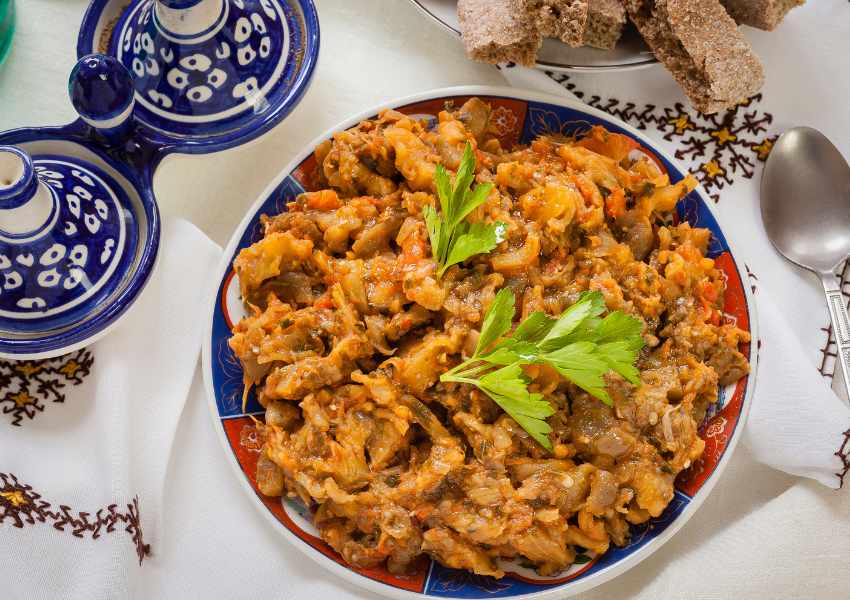
Vegan Options
If you’re vegan, you might have a harder time finding options in Marrakech. Many traditional Moroccan dishes contain meat or dairy, but there are still plenty of vegan options to try. Here are a few dishes you should look out for:
- Harira: Harira is a traditional Moroccan soup that is usually made with lamb or beef, but vegan options are available. The soup is made with lentils, chickpeas, and tomatoes and is a filling and hearty meal.
- Chermoula: Chermoula is a sauce that is used in many Moroccan dishes. It’s made with herbs, spices, and olive oil and is vegan-friendly.
- Fava Beans: Fava beans are a popular street food in Marrakech and are vegan-friendly. They’re usually served with bread and spices and make for a quick and tasty snack.
Food Etiquette and Traditions in Marrakech
When it comes to dining in Marrakech, there are certain etiquette and traditions that you should be aware of. Here are a few things to keep in mind:
Eating with Your Hands
In Marrakech, it is common to eat with your hands, specifically with your right hand. The left hand is considered unclean and is typically used for other purposes, such as washing. If you are not comfortable eating with your hands, it is okay to use utensils, but keep in mind that it may be seen as unusual.
Sharing Food
Sharing food is a common tradition in Marrakech. It is typical for dishes to be served family-style, with everyone sharing from the same plate. If you are dining with locals, it is polite to wait for them to begin eating before you start.
Tea Time
Tea is an important part of Moroccan culture and is often served throughout the day. When offered tea, it is customary to accept, even if you do not plan on drinking it. It is also polite to pour the tea using your right hand and to hold the cup with your right hand as well.
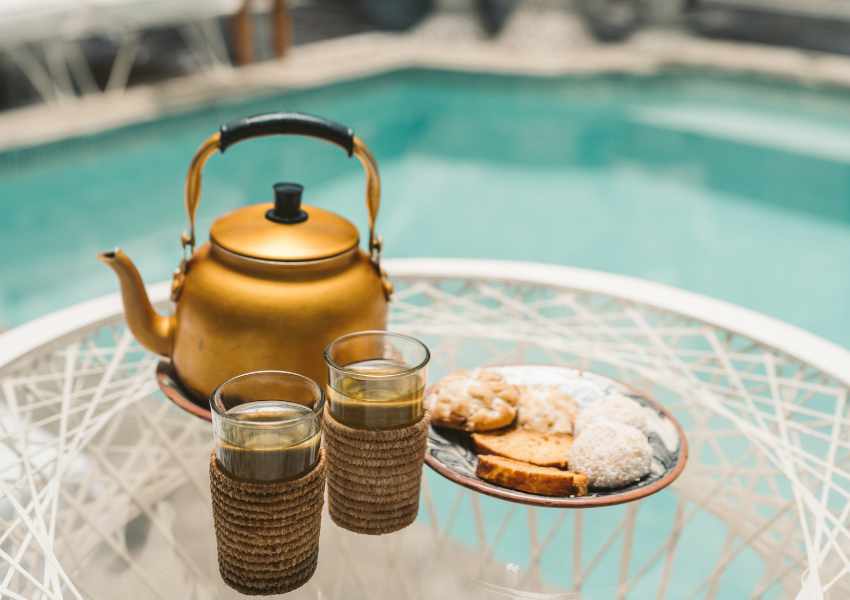
Ramadan
If you are visiting Marrakech during Ramadan, keep in mind that many restaurants and cafes may be closed during the day. It is also important to be respectful of those who are fasting, which means refraining from eating or drinking in public during daylight hours.
Dress Code
While there is no strict dress code for dining in Marrakech, it is important to dress modestly out of respect for the culture. This means avoiding revealing clothing and covering your shoulders and knees.
Marrakech Food Tours
If you want to get the best out of Marrakech food, there’s no better way to do so than by joining a tour led by a local who knows the best spots and dishes. Here are two wonderful options:
- Marrakech Street Food Tour At Night: This tour takes you on a culinary journey through the heart of the Medina at night, where you’ll sample traditional Moroccan dishes like tagine, harira soup, and pastries.
- Guided Street Food Walk and Taste Tour: This tour is perfect for foodies who want to explore the local street food scene in Marrakech. You’ll visit the city’s best stalls and finish off with dinner at a secret rooftop restaurant.
Marrakech Cooking Classes
Take things to the next level and learn how to cook your own dishes by joining a cooking class! Here are two excellent choices:
- Certified Moroccan Cooking Class at House of Fusion: This tour takes you beyond just tasting the food and allows you to learn how to cook traditional Moroccan dishes. You’ll visit a local market to buy ingredients, then head to a cooking school where you’ll learn how to make your own dishes guided by a professional.
- Marrakesh cooking class with chef Hassan: Learn how to make traditional Moroccan dishes, including tagine and other delicacies alongside a chef inside his own home! You’ll get to shop for ingredients at a local market, cook your own meals, and take tea breaks on a rooftop with beautiful panoramic views of the mountains.
Marrakech Food: Conclusion
In conclusion, Marrakech is a food lover’s paradise. The city’s cuisine is a perfect blend of flavors, spices, and textures that will tantalize your taste buds.
From the street food stalls to the high-end restaurants, Marrakech has something to offer for everyone.
Whether you are a meat lover or a vegetarian, you will find a variety of dishes that will satisfy your cravings. So, if you are planning a trip to Marrakech, make sure to indulge in the local cuisine and experience the city’s vibrant food culture.

One Comment